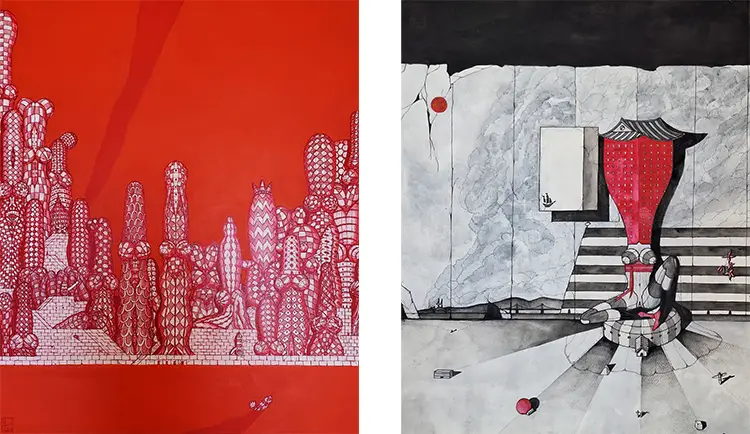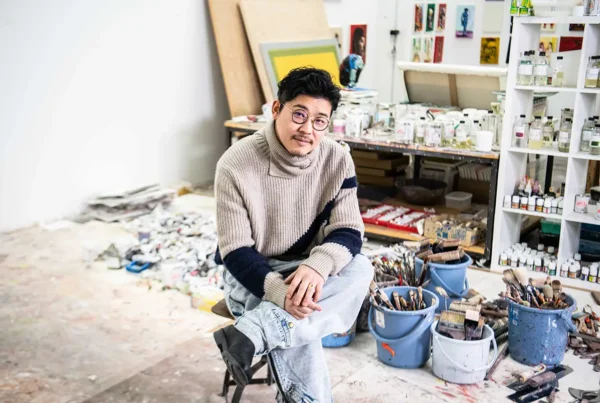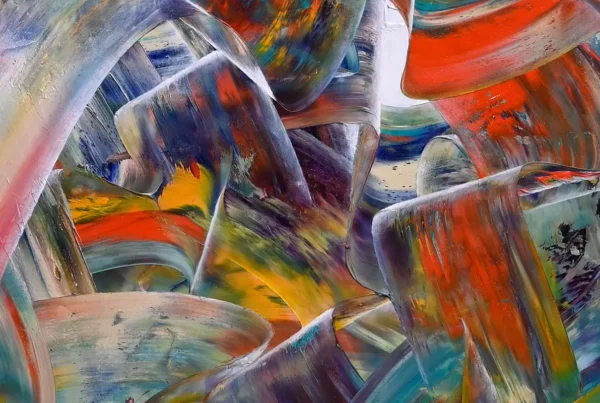“My work is rooted in the traditions of visionary, narrative, and paper architecture, but I push these concepts further by transforming buildings into human-like figures.”
Between Beams and Brushstrokes
In the vibrant intersection of art, narrative, and constructed space, the work of Won Ch. Kimetarx emerges with remarkable clarity and originality. A Canadian artist and writer of Korean heritage, he bridges disciplines with a dual foundation: a Master’s degree in Architecture from École Nationale supérieure d’Architecture de Strasbourg and a Master’s in History from Université Marc-Bloch. His transition from licensed architect in France and Canada to a full-time artist in 2017 marked a pivotal shift—from shaping physical structures to constructing imaginary ones. His debut, crowned with the Jury Prize at Montreal’s MTL en Art art fair, signaled a confident entrance into the art world, one that continues to blur the boundaries between theoretical design and emotional expression.
Kimetarx’s work resists simple classification. He refers to his artistic world as a “Glade,” a metaphorical clearing that appears unexpectedly in the dense forest of architecture. This imagined site becomes the stage where fragments of architectural forms meet story, emotion, and speculation. His pieces are not standalone paintings; they are thought-structures—visual schematics of ideas and allegories. Drawing from traditions such as visionary and paper architecture, Kimetarx rejects the conventional, space-dominant approach in favor of a narrative-centered one, where the architectural language becomes symbolic and expressive rather than purely functional. Within this terrain, humanized building-forms rise like dreamlike protagonists, each carrying conceptual weight.
The notion of illustration becomes crucial to his practice—not in the commercial sense, but as a philosophical stance. These artworks act as visual essays, each painting unfolding as an illustrated story or idea. He intertwines narrative, history, and design to question how architecture is not just about shelter or structure, but about identity, presence, and even memory. This imaginative pursuit reflects his desire to forge a renewed language for architecture through visual speculation, inviting the viewer not into a space, but into a moment of recognition, confrontation, or reflection.
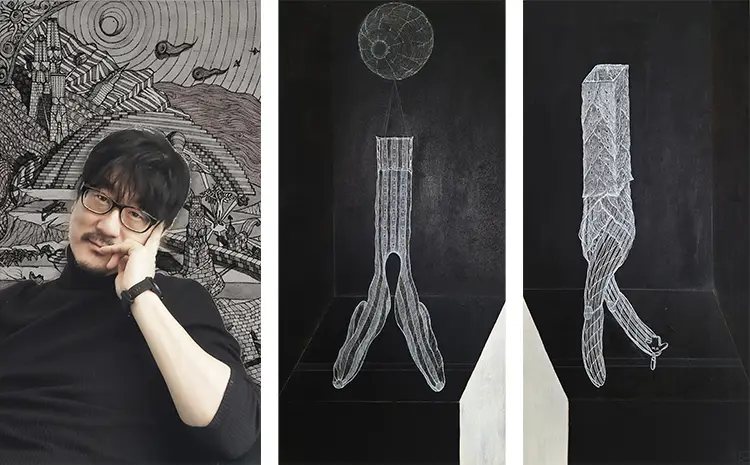
Won Ch. Kimetarx: Incarnated Architecture as Mythic Form
Kimetarx describes his artistic style as “painting as incarnated architecture,” a phrase that encapsulates his most compelling conceptual innovation: transforming buildings into human-like figures. In doing so, he dissolves the rigid line between the animate and the constructed. These aren’t anthropomorphic buildings in the traditional sense, but philosophical embodiments—bodies that reveal the soul of structures and structures that reflect human existence. His figures are mythic, yet grounded in architectural language, bending beams into limbs, and façades into faces. His artworks speak to the uncanny feeling of life lived within architecture, a space both intimate and monumental.
At the center of Kimetarx’s practice is an exploration of “the thing-itself”—an abstract but potent idea aimed at grasping the core essence of objects. By incarnating structures as bodies, he proposes a radical rethinking of what architecture means. No longer inert or neutral, the buildings in his paintings become sentient presences, capable of expressing isolation, power, trauma, or transcendence. He draws from traditions of narrative architecture and infuses them with fantastical elements, using painterly methods to collapse time, perspective, and scale. The boundary between skin and wall, body and façade, is constantly shifting—an effect both disorienting and captivating.
The influence of Louise Bourgeois is evident, especially in her “Femme Maison” series, which also addressed the intimacy and tension between the human form and domestic space. Like Bourgeois, Kimetarx examines what it means to inhabit and be inhabited. But where Bourgeois often turned inward to the psychological interior, Kimetarx casts his gaze outward to architectural allegory. His figures are not trapped within buildings—they are the buildings. Through this haunting metaphor, he challenges viewers to ask: where does architecture end, and where do we begin?
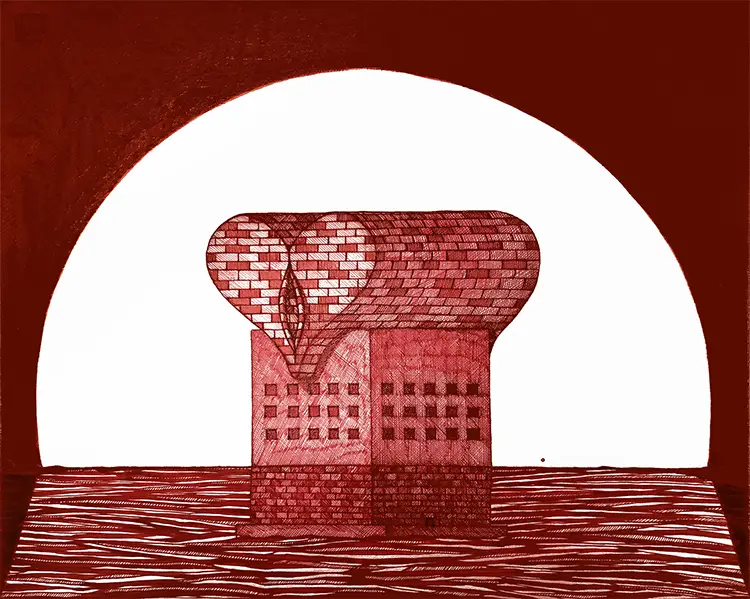
The Glade as Studio: Discipline Meets Imagination
Kimetarx’s studio is carefully calibrated to suit the demands of two-dimensional creation, offering a quiet refuge where theoretical exploration can manifest into visual form. This environment, stripped of distractions, is essential to his creative process, which demands clarity of thought and visual precision. Within these confines, his work evolves slowly, reflecting deep internal dialogues about form, meaning, and representation. While he acknowledges the potential richness of working in three dimensions, he also recognizes the complexity and chaos it might introduce—a contrast to the focused intent of his current methodology.
His journey as an artist began with humble tools: pencil and watercolor on paper. This early approach allowed for direct engagement with the surface, emphasizing intimacy and immediacy. Over time, his techniques expanded to include acrylic on canvas and wood panels, along with acrylic ink and metallic pen work. These materials offer the structural contrast he seeks—blending bold architectural lines with delicate visual textures. The layered surface becomes an echo of both body and building, creating artworks that are at once architectural schematics and emotional portraits. Each mark functions as both construction and expression.
Central to Kimetarx’s visual language is the balance between the rational and the fantastical. His architectural training ensures that every image is grounded in a sense of form and proportion, yet his historical and philosophical interests guide his imagery toward something symbolic and open-ended. This duality infuses his pieces with tension and nuance—engineered yet organic, rational yet surreal. It is this balance that gives his figures their uncanny presence, standing not just as aesthetic objects but as inquiries into how we live, build, and imagine.
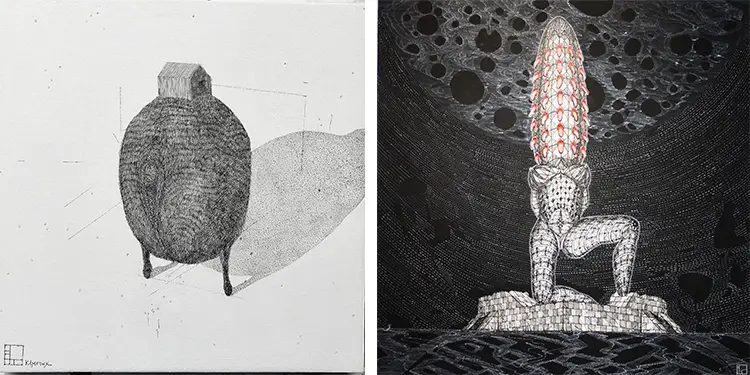
Won Ch. Kimetarx: From Paper to Pavement, Vision Becoming Structure
A defining moment in Kimetarx’s artistic trajectory arrived with Art save our Queen of Architecture (2022), a painting that crystallized his core concepts into a single, commanding work. Fusing elements of narrative, visionary, and paper architecture, the piece reaches beyond aesthetics to become a philosophical statement. Selected for exhibition at the 2023 L.A. Art Show by Studio ArtEgo, it marked a significant career milestone. The critical response reaffirmed his position as a distinct voice in contemporary architectural painting—one who uses allegory not as decoration, but as a mode of inquiry.
While his practice remains rooted in two-dimensional work, Kimetarx harbors ambitious plans to bring his “human-building” figures into the urban landscape. These future projects aim to transform the allegorical figures of his paintings into physical, habitable structures. Whether realized as public installations or temporary constructions, such work would bring his conceptual architecture full circle—reintroducing it into physical space but retaining its speculative essence. This would not merely be an extension of his art, but a translation: a migration from idea to matter, from canvas to community.
Through all of his explorations, Kimetarx remains committed to challenging how architecture is perceived—not just as utility, but as a carrier of story, memory, and identity. With his background in history and architecture, he offers a vision that is as intellectual as it is emotional. His art does not dwell in nostalgia or critique but seeks to open new imaginative spaces. In an age where architectural experience is often reduced to metrics and function, Kimetarx reclaims it as something living, embodied, and resonant with human experience.
